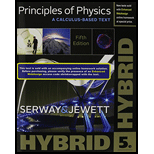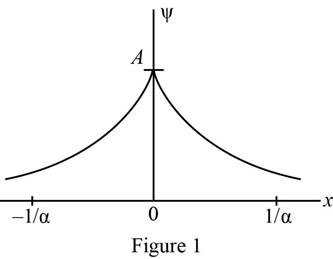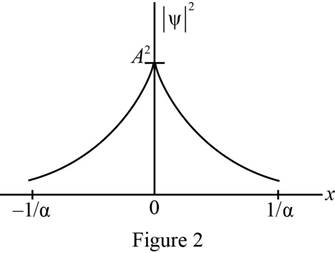
Concept explainers
(a)
Plot of wave function as a function of
(a)
Answer to Problem 74P
The wave function was plotted as a function of
Explanation of Solution
Write the given wave function of the electron.
Here,
Write the formula to calculate the probability of finding a particle in a certain range.
Here,
Refer equation (I) and plot the wave function as a function of
Figure 1 below shows the plot of wave function.

Conclusion:
The wave function was plotted as a function of
(b)
Plot of probability density as a function of
(b)
Answer to Problem 74P
The probability density was plotted as a function of
Explanation of Solution
Write the given wave function of the electron.
Here,
Write the formula to calculate the probability of finding a particle in a certain range.
Here,
Refer equation (II) and plot the probability density as a function of
Figure 2 below shows the plot of wave function.

Conclusion:
The probability density was plotted as a function of
(c)
To show that
(c)
Answer to Problem 74P
The
Explanation of Solution
Write the given wave function of the electron.
Here,
For the wave function to be a reasonable wave function, there are set of condition.
The
As
The
The
Conclusion:
The
(d)
To normalize the wave function.
(d)
Answer to Problem 74P
The normalization constant of the given wave function is
Explanation of Solution
Write the given wave function of the electron.
Here,
Write the condition for normalized wave function.
The wave function is symmetric. Thus re-write the above condition.
Substitute equation (I) in the above equation.
Conclusion:
The normalization constant of the given wave function is
(e)
The probability of finding the electron in the range
(e)
Answer to Problem 74P
The probability of finding the particle in the range
Explanation of Solution
Refer section (d) and write the given normalized wave function of the electron.
Here,
Write the formula to calculate the probability of finding a particle in a certain range.
Here,
Refer equation (II) in equation (III) to determine probability in range
Conclusion:
The probability of finding the particle in the range
Want to see more full solutions like this?
Chapter 28 Solutions
Principles of Physics: A Calculus-Based Text, Hybrid (with Enhanced WebAssign Printed Access Card)
- Shrinking Loop. A circular loop of flexible iron wire has an initial circumference of 161 cm , but its circumference is decreasing at a constant rate of 15.0 cm/s due to a tangential pull on the wire. The loop is in a constant uniform magnetic field of magnitude 1.00 T , which is oriented perpendicular to the plane of the loop. Assume that you are facing the loop and that the magnetic field points into the loop. Find the magnitude of the emf E induced in the loop after exactly time 9.00 s has passed since the circumference of the loop started to decrease. Find the direction of the induced current in the loop as viewed looking along the direction of the magnetic field. Please explain all stepsarrow_forwardA circular loop of wire with radius 0.0480 m and resistance 0.163 Ω is in a region of spatially uniform magnetic field, as shown in the following figure (Figure 1). The magnetic field is directed out of the plane of the figure. The magnetic field has an initial value of 7.88 T and is decreasing at a rate of -0.696 T/s . Is the induced current in the loop clockwise or counterclockwise? What is the rate at which electrical energy is being dissipated by the resistance of the loop? Please explain all stepsarrow_forwardA 0.333 m long metal bar is pulled to the left by an applied force F and moves to the left at a constant speed of 5.90 m/s. The bar rides on parallel metal rails connected through a 46.7 Ω resistor, as shown in (Figure 1), so the apparatus makes a complete circuit. You can ignore the resistance of the bar and rails. The circuit is in a uniform 0.625 T magnetic field that is directed out of the plane of the figure. Is the induced current in the circuit clockwise or counterclockwise? What is the rate at which the applied force is doing work on the bar? Please explain all stepsarrow_forward
- A 0.850-m-long metal bar is pulled to the right at a steady 5.0 m/s perpendicular to a uniform, 0.650-T magnetic field. The bar rides on parallel metal rails connected through a 25-Ω, resistor (Figure 1), so the apparatus makes a complete circuit. Ignore the resistance of the bar and the rails. Calculate the magnitude of the emf induced in the circuit. Find the direction of the current induced in the circuit. Calculate the current through the resistor.arrow_forwardIn the figure, a conducting rod with length L = 29.0 cm moves in a magnetic field B→ of magnitude 0.510 T directed into the plane of the figure. The rod moves with speed v = 5.00 m/s in the direction shown. When the charges in the rod are in equilibrium, which point, a or b, has an excess of positive charge and where does the electric field point? What is the magnitude E of the electric field within the rod, the potential difference between the ends of the rod, and the magnitude E of the motional emf induced in the rod? Which point has a higher potential? Please explain all stepsarrow_forwardExamine the data and % error values in Data Table 2 where the mass of the pendulum bob increased but the angular displacement and length of the simple pendulum remained constant. Describe whether or not your data shows that the period of the pendulum depends on the mass of the pendulum bob, to within a reasonable percent error.arrow_forward
- Please graph, my software isn't working - Data Table 4 of Period, T vs √L . (Note: variables are identified for graphing as y vs x.) On the graph insert a best fit line or curve and display the equation on the graph. Thank you!arrow_forwardI need help with problems 93 and 94arrow_forwardSince the instruction says to use SI units with the correct sig-fig, should I only have 2 s for each trial in the Period column? Determine the theoretical period of the pendulum using the equation T= 2π √L/g using the pendulum length, L, from Data Table 2. Calculate the % error in the periods measured for each trial in Data Table 2 then recordarrow_forward
- A radiography contingent are carrying out industrial radiography. A worker accidentally crossed a barrier exposing themselves for 15 seconds at a distance of 2 metres from an Ir-192 source of approximately 200 Bq worth of activity. What dose would they have received during the time they were exposed?arrow_forwardIn the following figure the circuit to the left has a switch thatat t = 0 s is switched and disconnects the battery from the circuit. The state depicted on thefigure is right after the switch, still t = 0. As the current decreases over time, the magneticflux through the circuit on the right (due to the long cable of the circuit on the left) changesand induces an EMF on the right circuit. How much power is consumed by R2 as a functionof time.The distance between the wire on the left and the closest wire on the right is r = 2.0 cm.The size of the circuit on the right is noted on the figure.arrow_forwardsingly A samply ionized helium atom is in the ground state. It absorbs energy and makes a transition to the n=7 excited state. The ion returns to wo the wavelength the ground state by emitting SIX photons ONLY. What is the of the second highest energy photon ?arrow_forward
 Principles of Physics: A Calculus-Based TextPhysicsISBN:9781133104261Author:Raymond A. Serway, John W. JewettPublisher:Cengage Learning
Principles of Physics: A Calculus-Based TextPhysicsISBN:9781133104261Author:Raymond A. Serway, John W. JewettPublisher:Cengage Learning Physics for Scientists and Engineers with Modern ...PhysicsISBN:9781337553292Author:Raymond A. Serway, John W. JewettPublisher:Cengage Learning
Physics for Scientists and Engineers with Modern ...PhysicsISBN:9781337553292Author:Raymond A. Serway, John W. JewettPublisher:Cengage Learning Modern PhysicsPhysicsISBN:9781111794378Author:Raymond A. Serway, Clement J. Moses, Curt A. MoyerPublisher:Cengage Learning
Modern PhysicsPhysicsISBN:9781111794378Author:Raymond A. Serway, Clement J. Moses, Curt A. MoyerPublisher:Cengage Learning Physics for Scientists and Engineers: Foundations...PhysicsISBN:9781133939146Author:Katz, Debora M.Publisher:Cengage Learning
Physics for Scientists and Engineers: Foundations...PhysicsISBN:9781133939146Author:Katz, Debora M.Publisher:Cengage Learning University Physics Volume 3PhysicsISBN:9781938168185Author:William Moebs, Jeff SannyPublisher:OpenStax
University Physics Volume 3PhysicsISBN:9781938168185Author:William Moebs, Jeff SannyPublisher:OpenStax Glencoe Physics: Principles and Problems, Student...PhysicsISBN:9780078807213Author:Paul W. ZitzewitzPublisher:Glencoe/McGraw-Hill
Glencoe Physics: Principles and Problems, Student...PhysicsISBN:9780078807213Author:Paul W. ZitzewitzPublisher:Glencoe/McGraw-Hill





